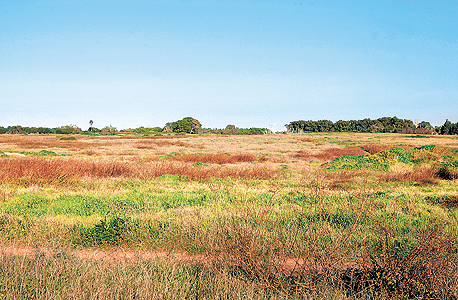Israel lags behind global efforts to halt deadly ‘superbugs’
India has just banned a ‘last-hope’ drug misused in livestock,
and the WHO has launched a campaign against drug-resistant bacteria.
But Israel isn’t doing very much.
חלם זה כאן: הרחיקו את אסדת הגז מחופינו ומבתינו
גלובס, 01.03.18
תעשייה פטרוכימית מול שמורת הטבע דור-הבונים היא אוטוטו מציאות, ועשויה להיות רק ההתחלה. רישומים ממדינת חלם, רגע לפני הטירוף.
שמורת אפולוניה היא אוצר לדורות
כלכליסט, 26.05.17
מול משוואת המדינה הליליפוטית שלנו ואוכלוסייתה הגדלה עומדים ערכי הטבע והנוף הבראשיתי של ישראל. במשוואה זו אין רחמים. הלחץ על משאבי הקרקע ודחף הבנייה הבלתי נשלט, המוסווה לעתים כניסיון לפתור את מצוקת הדיור, מפילים קורבן בזה אחר זה את השדות, מרבדי הפרחים, השועלים והתנים. ב"ארץ הצבי", מסתבר, אין אפילו מקום לצבי התנ"כי, שמספריו פחתו ב-70% ב-15 השנים האחרונות בלבד.

Born Free - In the City
SPNI News, April 25, 2018
Three years after its founding and just in time for Passover, Jerusalem’s Gazelle Valley Park has much to celebrate as the arrival of two wobbly wonders – Rubi and Pesach – brings this community to 5 times its original size.

Colors and their Symbolism in Judaism
National Geographic Hebrew edition, July 1999
It all began with the multicolored coat that Jacob gave to his youngest and most beloved son. As Genesis relays, Joseph’s brothers, burning with jealousy, then sell him to a convoy of Ishmaelites heading toward Egypt. And the rest, of course, is history. (Translated from Hebrew.)

Pomegranates, Grapes and Olives
Israeli research of natural medicines
National Geographic Hebrew edition, April 2000
“Only her eyes were visible through her traditional headcovering. Believed to be infertile,
she was squatting over a steam bath filled with plants. We were told that the treatment would continue
for three days, followed by intercourse,” recalls Prof. Zohara Yaniv of her visit with Sheik Sala'am,
a medicine man from the Bedouin Gebaliah tribe in Egypt's Sinai Mountains.
(Translated from Hebrew.)

Of Goats and Treasured Scrolls
National Geographic Hebrew edition, July 2000
This story begins and ends with goats, but its middle holds one of the most important archaeological
discoveries of the 20th century – the Dead Sea Scrolls. Discovered in 1947,
by a Bedouin lad who crawled into a mountain cave in search of a lost goat, the scrolls,
written in Hebrew, Aramaic and Greek,
contain the entire Old Testament, excluding the Book of Esther. (Translated from Hebrew.)

Hidden Treasure in Garlic
National Geographic Hebrew edition, July 1999
You may shy away from that special kiss right after eating garlic, but the Talmud actually sings its love-boosting praises.
“It satisfies hunger, brightens your complexion, boosts your sperm and kills off parasites. And some believe it even brings on love and banishes jealousy.” (Translated from Hebrew.)

Innocent Poppy
National Geographic Hebrew edition, March 1999
“The police called me into the station and interrogated me for hours.
I had to convince them that this was a rescue operation”
recalls Prof. Arieh Levi, of Israel’s Agricultural Research Organization. (Translated from Hebrew.)

Genetic Tower of Babble
National Geographic Hebrew edition, October 1999
Is there a Jewish genome? What is the origin of the Bedouin Jabaliya tribe in the Sinai Desert?
Why is breast cancer prevalent amongst Jewish Ashkenazi women?
These are some of the questions tackled by researchers in the genetic
goldmine of Israel – now home to Jews from all corners of the world. (Translated from Hebrew.)

Going Up
Interview with Ilan Ramon, the First Israeli Astronaut
National Geographic Hebrew edition, June 1999
"Imagine being asked if you want to reach the moon.
That’s more or less how it sounded to me when first asked if I wanted to undergo
NASA's astronaut training," remembers Colonel Ilan Ramon, Israel's first astronaut.

Running away from your Dreams
Sleep and Dreaming in Holocaust Survivors
National Geographic Hebrew edition, August 1999
In 1944, at age 14 “K” was sent to Auschwitz, separated from his mother, and sent to the “twin barracks,” site of the infamous medical atrocity experiments performed by Nazi physician Joseph Mengele. K was liberated in 1945. (Translated from Hebrew).

Species Conservation
National Geographic Hebrew edition, April 1999
Thousands of species across the world are on an ever-growing list that they'd much rather have avoided – the ticking clock of endangerment. While scientists and conservationists are scrambling to tackle this challenge - creating nature reserves and freezing sperm and embryos – these methods are costly and limited. (Translated from Hebrew.)

Water Goes Green
National Geographic Hebrew edition, December 1999
Israel develops two novel water purification technologies, both based on a simple concept – team up with naturally present elements within the water ecosystem. (Translated from Hebrew.)

Cinnamon and Myrrh – Perfume in the Bible
National Geographic Hebrew edition October 1998
According to Jewish tradition, our scent buds are the only sense that did not take part in the original sin, and therefore remained pure and pristine as in the first moments of creation. No wonder, then, that it so influences our thoughts and behavior. (Translated from Hebrew.)

Blinding Bugs
National Geographic Hebrew edition March 1999
“Why use chemicals? Simply hide the food. This is the idea we’ve taken in a new form of biological control that distorts the insect’s visual capacity, by filtering out ultraviolet rays,” explains Dr. Hezi Antignus of Israel’s Agricultural Research Organization. (Translated from Hebrew.)

Secret of the Lost Gene
National Geographic Hebrew edition, October 1999
Four years ago, while visiting a synagogue in Toronto, Prof. Karl Skorecki glanced curiously at a fellow congregant, who was also a Cohen (a title transferred from father to son, of males thought to be descendants of the Biblical high priest Aaron). “Can he and I be distantly related, as the ancient tradition implies?” Skorecki wondered. (Translated from Hebrew.)

Bacterial Rags to Riches
Newly discovered bacterium gobbles up problematic pesticide
Field & Mind, Spring 2000
Psuedomonas sp. strain ADP began its climb to notoriety a few years ago from a cornfield somewhere
in Minnesota. Not a particularly high-profile beginning for a scientific finding
that could alleviate the environmental problems posed by the most heavily used pesticide worldwide.

Infesting Insects Turn a Blind Eye
Field & Mind, January 1999
Scanning the landscape using a high precision detection system guided by unique wavelengths invisible to the human eye,
they planned to move in for the kill. But the target, hidden by UV absorbing camouflage, avoided discovery.

Car Wash Concept Gleans Millions in Post-Harvest Breakthrough
Field & Mind, January 1999
In 1995, Dr. Eli Fallik, a plant pathologist at the ARO's Department of Post-Harvest Science,
walked onto a farm in the Negev and suggested a simple yet powerful solution to the post-harvest pepper
losses. "Wash them," he said. "The farmer jokingly asked that I leave," recalls Fallik with a smile.
At the time,
the thought of washing vegetables or fruit following harvest was unheard of. I told him I'd be back.

Drink to Your Heart's Delight
Field & Mind, January 1999
It's been dubbed the French Paradox. There is a strong link between saturated fat consumption
and heart attack related mortality. However, heart disease levels are surprisingly low among the
French (one third the levels in northern Europe and the USA) despite their passion for rich cuisine and cigarettes.

Kosher Chickens Show the Way to a Scar and Cancer-Reduced Future
Field & Mind, Spring 2000
A few years back, an Israeli farmer mistakenly overdosed his chickens with halofuginone - an anti-parasitic routinely
administered to poultry. The result: increased skin tearing during the koshering process gave rise to a flurry of
scientific research that may lead to groundbreaking therapies for diverse skin pathologies and cancer.

A New Generation on Ice
New freeze technology transforms genetic optimization and preservation
Field & Mind, January 1999
Staring back at me with lovely warm calf eyes, Zegugit looks wonderful -- especially considering what
she's been through. "As an embryo, she endured the fastest deep-freezing
process ever experienced by a living being, be it bacteria or mammal," says Dr.
Amir Arav, of the ARO's Department of Animal Reproduction.

Engineering Seduction
Field & Mind, Spring 2000
Serenaded by waves along the California coastline,
unusual partners meet fleetingly under the cover of darkness.
Guided by its attraction to two scents - one clove-like and pungent,
the other refreshingly light, lemony, and sweet, the hawkmoth zeros
in on nectar produced by the flower Clarkia breweri.

Switching on the Charm
Field & Mind, Spring 2000
Check one or more of the following boxes if you:
- Want to dazzle your lover with an exquisitely formed, new-to-science flower.
- Groan at the thought of spring flowers, pollen and allergy-season.
- Are a farmer hoping to reap 20 percent more profit from your alfalfa and clover fields.

Fuming out Methyl Bromide
Field & Mind, Spring 2000
Dr. Giora Kritzman is a man with a mission, and a rapidly approaching deadline - - which he intends to meet.
“By 2005, the target date set by the Vienna Committee for completely phasing out methyl bromide usage in the West,
farmers will have an effective contingency plan,” says Kritzman of the ARO’s Plant
Pathology Department and Chairman of Israel’s Committee for Methyl Bromide Substitutes.

The China Israel Exchange
Similar Agricultural Challenges Fuel Cooperation between Israel and China
Link. June/July 1999
What image comes to mind when
you think of Chinese agriculture? If you've answered
lush, water submerged fields you're in the majority.
Turns out, however, that much of China is actually a
desert.

The Effect of the Defect
Rather than impair function, certain defects enhance solar cell
efficiency
Interface Fall/Winter 2004
Iris Visoly-Fisher knew
exactly what she wanted to work on when starting her
Ph.D. - to follow up on a hunch that defects in a certain
material used in solar cells would actually improve their
performance. But something was bugging her. She couldn’t
understand why so few people were working on this topic.
“It was a no-man’s-land,” she says. “It seemed clear that
something was up, but there was virtually no literature
on it.”

Going Magnetic
Interface Fall/Winter 2004
When Itai Carmeli first came to his Ph.D. adviser with his results,
he was gently told to get back to work. “I told him there was no such physics,”
recalls a smiling Prof. Ron Naaman of the Institute’s Chemical Physics Department.
“A year later he was back - with similar findings.”
Carmeli had been tinkering around with organic molecules,
which he used to create extremely thin, single-layered films on a
gold substrate. The surprise was that the films were behaving like a
powerful magnet.

The Slick Joint
News Briefs Interface Fall/Winter 2004
Body joints are superbly lubricated. They have to be.
As the meeting point between every two bones in our body,
they are what makes our every movement possible - from walking,
bending and maneuvering our fingers to playing ball and dancing.
And they’re supposed to last a lifetime.
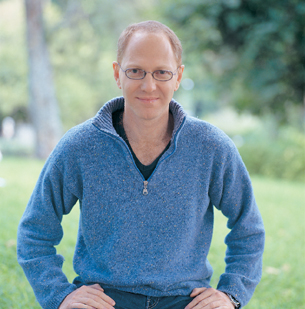
Ancient Cast New Production
First artificial circuit hooks up genes outside the cell
Interface Spring/Summer 2004
Shaped through time, biological cells are the ultimate engineering systems, able to perform the most advanced information processing known. They also produce a wonderland of materials - from over 100,000 proteins to the materials they help build: skin, record-strong spider webs, horns and far more. The cell pulls off these feats in a tiny setting that engineers can only dream of. How do its systems work? Might they be harnessed to build superfast computers or advance new biotechnologies?
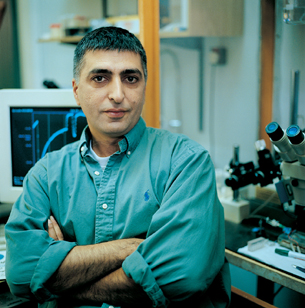
The Body Electric
How do cells open and close their communication channels? What makes life electric?
Interface, Spring/Summer 2004
A brilliant flash of lightning streaks across the evening sky followed by a sharp crack of thunder. As you rush upstairs to close the bedroom window, the millions of cells making up your heart muscle continue their endless task of contracting and relaxing in concert, guided by a small group of conductor cells. You then turn up the heater, relishing the wave of hot air as it meets your skin.

NMR - The Movie
New approach captures the ‘heart of matter’ at record speed
Interface Spring/Summer 2004
Lucio Frydman devotes much of his time to one of the oldest traditions of humankind - making tools and using them to explore the world that surrounds us. But things have changed quite a bit since early blade-shaping, fire-making and glass-blowing attempts. “The goal is to craft ever-sensitive recording methods for peering into the heart of matter,” says Frydman, a professor in the Institute’s Chemical Physics Department.
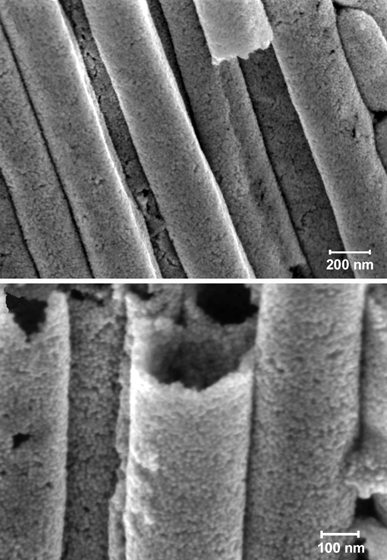
Tubes with a Twist
New type of gold and silver nanotubes developed at the WIS
Interface Spring/Summer 2004
In a discovery filled with surprises, Institute scientists have created a new type of nanotube made of gold, silver and other metals. Made at room temperature - a first time achievement - the tubes exhibit unique electrical and optical properties, and may lead to a variety of applications in medicine, industry and security systems.
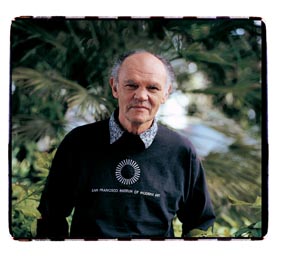
Malaria's Achilles' Heel
Researchers uncover the mechanism of malaria-fighting drugs
Interface Fall/Winter 2003
Malaria is a leading killer. While mostly confined to sub-Saharan Africa, regions in Asia, and Central and South America, it infects an estimated 300 to 500 million people every year and kills between one and three million, most of them children under the age of five.

Making Your Mark
New educational program for Ethiopian youth opens the door to new kingdoms
Interface Spring/Summer 2003
Challenged to find a way of drawing a multi tower castle, 13-year-old Betty Gallai thinks for a moment, and then leans forward to her keyboard, firing out a string of programming commands. Within seconds her screen starts filling up with lines, with a friendly-looking turtle icon leading the way.
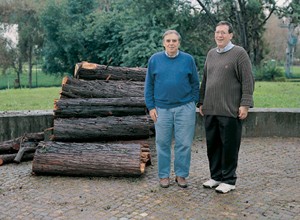
X-rays Yield Mechanism of Alzheimer's Drug
Interface Spring/Summer 2003
A team of Weizmann scientists has gained new insight into the effects of a newly approved drug, rivastigmine, in treating Alzheimer’s disease, a debilitating brain disease causing memory loss in around 10% of the elderly. The study was published in the American Chemical Society journal Biochemistry.

Looking for Trouble
How immune cells reach the eye of the storm
Interface, Fall/Winter 2002
It looks like Monday morning rush hour viewed from high above. Hundreds of tiny dots are scurrying down the screen while a parallel fleet heads north. Every once in a while, one of these bright spots stops in its tracks, turns left or right, and subsequently disappears from view.

Cancer Fights Back
Sometimes the good guys turn against their comrades in arms
Interface, Fall/Winter 2002
It's war. And it's not just "out there," but inside our bodies, where a fleet of immune agents is constantly on the lookout for rogue invaders - viruses, bacteria, and fungi. Over the past few decades, as scientists have tirelessly traced the micro-trenches of our body's battle zones, scoring increasingly promising victories in the form of antibiotics, vaccines, and even the anti-AIDS-virus cocktail, hopes have risen that one day we may also succeed in targeting foes from within, such as cancerous tumors.

Blocking Type 1 Diabetes
WIS develop the first successful vaccine for Type 1 diabetes
Interface Spring/Summer 2002
A team of researchers led by Prof. Irun Cohen of the Weizmann Institute of Science has developed a vaccine that halts the progression of Type I (juvenile or insulin-dependent) diabetes. The vaccine functions by blocking the destruction of insulin-secreting pancreatic cells.

A Plant's Brainy Balancing Act
Lysine production in plants sheds light on the human brain
Interface, Spring/Summer 2002
Plants are brainless. True, they have other winning traits - like the ability to withstand searing summer skies or biting frost (they can't pack up and leave when times get rough). Nevertheless, they lack the neuron-based information processing found in animals, from the single-neuron system found in sea anemones and hydras to the remarkably complex human brain.

Heart Gene Hunt
Interface, Spring/Summer 2002
When Leilah* began showing the dreaded symptoms at age 8, her parents quickly turned to the medical community for help. Having earlier lost two children to this mysterious disease, they recognized its signs. She was diagnosed with polymorphic ventricular tachycardia (PVT) a fatal heart condition. Primarily affecting young children, PVT is characterized by a fast and irregular heartbeat, seizures, and in certain cases, sudden death - particularly following physical exertion or emotional stress.
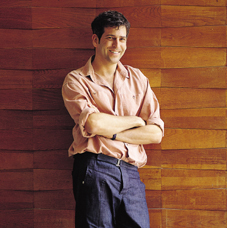
Cell Wizardry
Weaving an ancient jellyfish defense strategy with computer algorithms, scientists are probing the computational feats performed by the living cell
Interface, Spring/Summer 2002
Life is about decision making. From humans down to unicellular organisms it's all about striking the best deal, finding the greenest pastures or, say, choosing the quickest escape route from fire, predators, or noxious chemicals. At the command post, on a submicron scale, lies the cell. First viewed by the human eye during the late 1600s but sporting billions of years of evolutionary polish, it easily rivals today's most advanced computers.
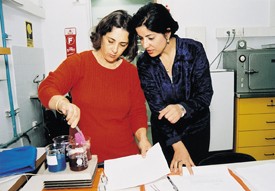
The Color of Success
Interface Spring/Summer 2002
Want to convey an earthy/natural look or one of quiet prestige and sophistication? Colors have a profound influence on our impressions, emotions, and at times even on the choices we make - which explains why advertisers carefully consider color in developing marketing strategies, and why most interior designers wouldn't paint a restaurant blue, generally considered an appetite suppressant. Yet despite their far-reaching effects most of us give little thought to how different colored paints are made and used - for instance, how car paints are formulated to withstand corrosion. A new program at the Weizmann Institute of Science may change all this.
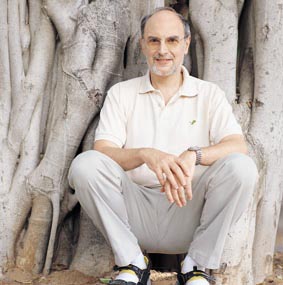
Gone (gene) Fishing
Big clues to common diseases sought in small genetic pond
Interface, Fall/Winter 2001
Born and raised in Belgium but pretty much a globetrotter ever since, Prof. Jacqui Beckmann has spent nearly 30 of his 50+ years hunting for genes. The former Associate Director of the French National Genotyping Center, and a leading molecular geneticist, Beckmann's gene sleuthing has included mapping the genes that cause limb girdle muscular dystrophy, kidney disease, mature onset diabetes, and hypertension.

Here's Lookin' at You
WIS discover that the brittlestar, long thought to be sightless, is all eyes
Interface Fall/Winter 2001
Sensing the growing shadow, it slithered away from its enemy, propelling itself with rapid, snakelike arm movements. Sounds like yet another episode in nature's daily drama of survival, but there's a puzzling catch - this creature doesn't have eyes.
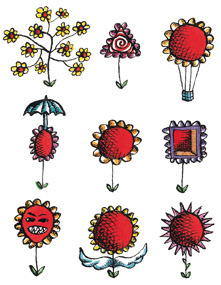
Playing the Odds - Mutation-Based Plant Success Strategies
Rapid evolution is crucial for plants, embroiled in a race for survival against formidable armies of fungi and bacteria
Interface, Fall/Winter 99
"Plants evolve far more rapidly than mammals," says Prof. Avi Levy of the Weizmann Institute's Plant Sciences Department. "In the last 300 million years, only 4,000 mammalian species have evolved, in contrast to nearly 200,000 flowering plant species exhibiting a plethora of shapes, colors, and adaptations." Plants also have much greater variation than mammals in the amount of DNA per species. This genomic plasticity may be the plant's answer to a main grievance: unlike mammals, they can't flee in the face of danger; they have no choice but to stand their ground.

Breaking the Bonds
Interface Spring/Summer 2000
Weizmann Institute researchers recently got more than they'd bargained for. While studying an enzyme pivotal to brain function and memory, they changed an experimental focus and ended up capturing the first-ever time-resolved "movie" demonstrating how molecules break apart when exposed to X-rays.

Gold at Sydney
Weizmann summer school graduate strikes Olympic gold
Interface Spring/Summer 2001
Great Britain's Stephanie Cook snatched a dramatic gold at the Sydney Olympics - pistol shooting, fencing, swimming, riding, and finally running her way to victory in the first ever Olympic women's pentathlon. But she's not only an all-round athlete. The 28-year-old started training full-time only a year earlier and then won Olympic selection at the World Cup Competition in Mexico. To do so, she had to put her career, as a physician, on hold.

To Find Cures for Cancer
Interface Fall/Winter 2000
When asked to predict future trends in cancer research, Prof. Leo Sachs responds resolutely: "Futurology in science has not been very successful. If I knew what would be important in five years time, I would do it now!"
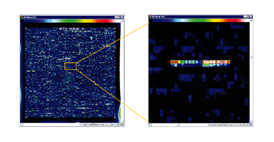
Chipping Away at the Genetic Code
Interface Fall/Winter 2000
Newly arrived at the Weizmann Institute of Science: DNA chips -- built of the stuff that genes (and research dreams) are made of. Offering greatly improved means for probing the molecular roots of disease and examining fundamental questions in the life sciences, DNA chips are a key addition to the research "toolbox" of Israeli scientists.
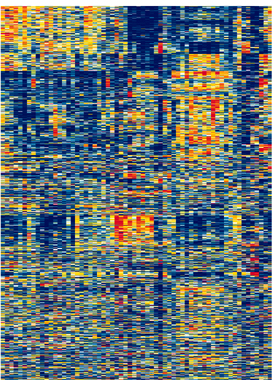
Data Cluster Control
Interface Fall/Winter 2000
Having received the command, the computer starts churning out information, systematically filling in tables and charting graph after graph. This may sound like a dream research scenario, yet as most scientists would quickly point out, it's just the beginning. The true challenge is to make sense of the data.

Unfolding the Secret of Protein Folding
Interface Fall/Winter 2000
Having completed a working draft of the human genome, widely hailed as one of the most significant intellectual achievements of all time, one might think that those involved would head home for a well-earned vacation. Far from it. They've rolled up their sleeves and are moving on with added speed. We now know how genes perform the cell's work, instructing it to string together different amino acids to create, say, a protein triggering blood clotting following injury, or a stomach enzyme to aid in food digestion. The next challenge is to better understand these gene products.
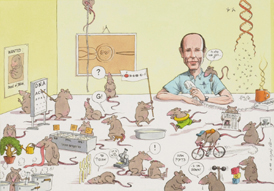
Genome Races
Landmark human genome project completed
Interface Fall/Winter 2000
Time was when highly trained and motivated teams, often urged on by patriotic fervor, would set out to explore vast geographical unknowns. Mount Everest, the Poles, and the moon were checked off one by one. The human genome project, say many, is this legacy's high-tech equivalent -- biology's moon landing.

Curbing the Clock
Interface Spring/Summer 2001
Sounding in part the shrewd financial investor, in part the philosopher, Prof. Abraham Amsterdam is fascinated by windows of opportunity - from an ovary's perspective, that is.

Protein Teamwork Do or Die
Interface Fall/Winter 2000
Woody Allen once said, "It's not that I'm afraid to die. I just don't want to be there when it happens!" Perhaps he was unaware of it, but if we're lucky, we all actually "die" a little every day. A growing body of scientific evidence is proving what philosophers and artists have preached for millennia -- that a healthful life is dependent on, driven forward, by death.

It's a Perfect Protein Match
Interface Fall/Winter 2000
Searching for a soul mate, new friends, or just fresh contacts? Turns out that proteins have similar goals. However, shaking off their single status generally doesn't come easy.

Ribosomal Revelations
Interface, Spring/Summer 2000
Leaning back in an office busy with mysterious images of rotating, luminescent molecules suspended in a jet-black vacuum, she laughingly recounts that her colleagues have at times called her a dreamer. Her goal, "to try to understand the principles of life from the inside by unraveling the detailed structure of ribosomes," has taken Prof. Ada Yonath of Weizmann's Structural Biology Department on a long uphill road strewn with technological and conceptual barriers.

Shooting the Messenger
Interface, Spring/Summer 2000
The age-old appeal to avoid 'shooting the messenger' is apparently left unheeded by the body's protein regulation system. Researchers at the WIS have recently uncovered one of the mechanisms underlying the synthesis and regulation of actin - the most abundant protein in eukaryotic cells. Their findings reveal an intricate autoregulatory system based on destroying actin's messenger RNA.
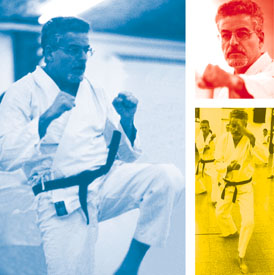
Fighting Cancer the Empty-handed Way
Interface, Spring/Summer 2000
Slicing the air in a flurry of powerful, yet calculated motions, Prof. Israel Rubinstein lashes out at his invisible foe with the mastery of a black belt karate fighter. Which in fact he is. When not in the lab, Rubinstein of the Weizmann Institute's Materials and Interfaces Department, seems to tackle unusual challenges - like picking up karate at age 45 in the Dojo (class) of Asher Chen, one of Israel's leading Shotokan instructors.
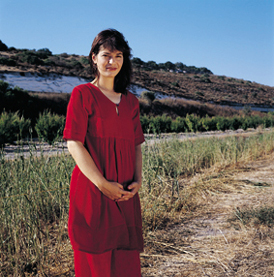
On Shaky Ground
How does the Earth move? What triggers landslides?
Interface, Spring/Summer 2000
They’re all around us – from dust, to sand dunes, to broken rocks in the earth’s crust, and even to
plant seeds or coffee. Known as granular materials, their definition is simple: a large collection of
macroscopic particles. But understanding their behavior is anything but simple – it’s strikingly
different from any of the familiar forms of matter: solid, liquid, or gas. A better understanding of
these minute particles could shed light on incredibly powerful and large-scale processes shaping
the Earth, including landslides or even earthquakes.

Juicy Prospects - New Exotic Desert Fruit to Boost Israeli Export Sales
COVER STORY
Israel Agritech, Spring 1998
Of the estimated 300,000 plant species worldwide, only a minute fraction serve as food, medicinal and industrial sources. The remainder comprise a vast, unexplored frontier bursting with possibility. Israeli scientists have made great strides in commercializing such wild plants in recent years. Now they are interested in expanding cooperative research projects between Israel and seed source countries.

Bio Warfare on Pests
Israel Agritech, Fall 98
Human creativity has given rise to an array of chemicals and techniques, including fertilizers and pesticides that lesson the farmer’s dependence on season and environment, as well as revolutionizing agricultural yields and quality. But experience has shown that insidious problems accompany agricultural progress as well.

Super Genes - Advanced Genetic Technologies in Agriculture
Cover Story
Israel Agritech, Winter 98
Forget Noah’s advice of loading the animals in the ark two by two to ensure their species’ continuation. Today, revolutionary advances in genetics and biotechnology enable us to store, pick, choose, and even mix genetic material from diverse plant and animal sources. Farmers have selectively encouraged advantageous traits through classical cross-breeding techniques for centuries. Yet, cutting edge recombinant DNA technologies — the ability to artificially transfer desirable traits between organisms, and even across the species barrier, opens up a radically new world of agricultural opportunities.

Fields of Terror? Genetic engineering in agriculture reaps praise and protest
Teva Hadvarim, January 1999
Goats producing a life-saving human enzyme, engineered tomatoes fitted with an ”intelligence unit” that protects them from fungus, and grapes that fight cancer and heart disease – while these may sound like sci-fi scenarios, they are underway in labs throughout Israel and the world. (Translated from Hebrew.)

Plants of Wandering Thoughts
Hallucinogenic plants & the human brain
Teva Hadvarim, April 99
Halucinogenic plants have both drawn and freightened us from the beginning of time. Cultures across the globe have attributed mystical and magical properties to these mood transforming masters, dubbing them "the plants of the Gods," and applying them in a fanciful array of ceremonies to heal the ill and communicate with higher spirits. (Translated from Hebrew.)

The Young & Restless - Budding Scientists Competition
Kimmat Alpaim, Spring 1999
Equipped with barrier-breaking telescopes, they spend all-nighters probing the mysteries of the sky, invent AI ‘chess masters’ that squash all opponents, build state-of- the-art sailboats drawing on a keen balance between improvisational prowess and geometrical theories and delve into the single cell level of an international study targeting the early detection of prostate cancer. (Translated from Hebrew.)

Gulf Stream Mysteries
Kimaat Alpaim, Summer 1999
Benjamin Franklin (1706 – 1790), is well known as a statesman, philosopher, inventor and scientist who probed the magic of electricity. Few, however, know that Franklin was also the first to reveal the mysteries of the famous Gulf Stream. (Translated from Hebrew.)

Green Invasion – Psychoactive Plants and the Human Brain
Kimaat Alpaim, Winter 1998
“We drank the Soma and will soon become
immortal, having reached the light, the Land
of the Gods. How, now, could the malice and
hostility of mortals hurt us?” (Translated from Hebrew.)

Beating the Odds
Shalom Magazine, 1998
A stunning variety of new and exotic fruits in enticing colors
and unsual shapes may soon find its way to Israeli tables and export,
providing Prof. Yosef Mizrahi and collegues Dr. Avinoam Nerd
and Dr. Genady Goldman get their way.









































































